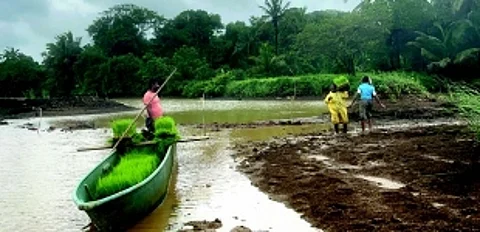Goa’s ‘Paddy Man’ innovates farming in Curtorim’s khazans, uses canoes to ferry machinery
CURTORIM: In the waterlogged khazan lands of Corjem, in Curtorim village, a scene unfolds that seems more suited to a picture postcard than an agricultural initiative: a canoe, traditionally used for serene backwater rides, now ferries modern farming equipment across flooded terrain. This unusual sight marks the ingenuity at the heart of a groundbreaking project led by Fr George Quadros of the Don Bosco Agricultural Unit, affectionately known as the ‘Paddy Man of Goa.’
The initiative tackles head-on the challenges that have long deterred large-scale mechanised farming in these waterlogged lands.
“We are in Corjem, at the far end of Curtorim. And what you see behind is the beautiful khazan lands of Goa,” says a beaming Fr George . “Beautiful, I say, because it’s absolutely thrilling and enjoyable to be working in this place at this moment of time.”
The project’s scale is ambitious, covering one lakh square meters. Fr George says, “We have taken a project as a challenge more than anything else. Because nobody would dare to put machinery in the khazan lands on a big scale, maybe 4,000 square metres as demo plots. We have done that in the past. But this time we are attacking one lakh square metres of khazans, and all by machinery.”
However, the real adventure began before planting. With high water levels, transportation became a unique challenge. “We had a little problem transporting the machine and then we are transporting the nursery,” Fr George explains, his voice tinged with pride. “And that we have succeeded very well because the locals have given us a canoe, and especially when we are transporting the machinery, the locals themselves paddle the boat across to the other piece of land across.”
This blend of traditional methods and modern technology is the cornerstone of this project to recultivate an area called Novar Khazan, which was left fallow for a variety of reasons for the last few years.
The choice of equipment was crucial. “We have tried to use the lightest machinery possible,” Fr George notes. “You would see a tractor being used, a big transplanter, a mini transplanter and work is going on pretty well.”
The project’s success hinges on a delicate balance of innovation and traditional knowledge. When faced with the risk of machinery sinking into the mucky terrain, the team devised a clever solution. “We had stationed a tractor inside, okay, a tractor without any equipment, without any implements to be precise,” Fr. George explains. “So it was very light and easy there and the moment any of our machinery sank, it was taken out within, say, a maximum of five minutes.” He also added that the local farmers took turns to monitor the fields throughout the day, which also played a big part in making this project a reality.
The choice of crop was rooted in local wisdom. “They have planted Jaya, which turned out to be successful here because the infiltration of the salt water did
not take place, as I heard, till the month of November,
and therefore gave them a good result.”
Fr George emphasises the importance of trusting the local farmer’s inputs, as he pointed out that each field, including a khazan field, of one village may differ from those of the next.
“Whatever the choice of the local farmer, they are the best fellows who know exactly what will work and what will not work. We are experts in machinery and speed and all that. So they, or any other group of farmers can tell us what they want, and we can give them what they want. That’s how it works.”
His vision extends beyond this single project; he views this initiative as a blueprint for preserving Goa’s agricultural heritage.
Rui Menezes, Chairman of Novar Khazan Tenant Association, thanked the farmers and Fr George for the initiative and also the Curtorim MLA Aleixo Reginaldo Lourenco for logistics support.
Menezes added that there was a gap in terms of the land being left fallow recently but echoed what Fr George said about their success with Jaya rice crop variety in the recent past. He explained that earlier they would grow the traditional Korgut, Assgo variety but they went with Jaya as it had a better yield and durability. The Goa PRIs Union Agrobiodiversity team members also provided support to this project.

